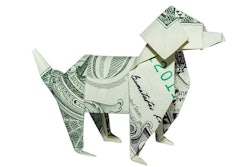
Analysts with Morgan Stanley believe the pet industry in the United States may reach US$275 billion by 2030, up from US$118 billion in 2019, fueled by increasing pet ownership and higher spending. Morgan Stanley Research and AlphaWise, the company’s survey and data group, reported on the forces influencing the sustained growth of the pet industry in the coming decade. One analyst stated that the industry may see topline compound annual growth rates near 8%, compared to 3% during the past decade.
AlphaWise market researchers surveyed U.S. households. More than half of respondents, 66%, had at least one pet. Many of those homes have more than one pet, since the average was 1.7 pets per household. Of those survey respondents, 69% strongly agreed that their pets were important members of the family. More than one quarter (29%) stated they would put a pet's needs before their own.
Pet ownership growth may also continue into the future, fueling U.S. pet industry growth. In the survey, 65% of 18- to 34-year-old respondents planned to acquire or add a pet in the next five years. AlphaWise forecast pet ownership to grow 14% by 2030.
That larger number of pet owners may also spend a larger amount on those pets. Morgan Stanley’s analysts believe average annual household spending per pet may increase from US$980 in 2020 to US$1,292 by 2025. That spending could increase to US$1,909 by 2030, while pet owners become less willing to reduce spending on pets.
The brands pet owners spend on may be influenced by their veterinarians. Approximately half of survey respondents said they would change brands following a veterinarian’s recommendation.
U.S. pet food spending rose in 2020, tracking sales growth
From previous reporting by Debbie Phillips-Donaldson, editor-in-chief of Petfood Industry: Pet food spending by U.S. consumers increased by more than 31% year over year (YOY) by mid-2020, according to data from the U.S. Bureau of Labor Statistics (BLS) reported and analyzed by John Gibbons, aka the Pet Business Professor.
This huge leap in reported spending corroborates similar growth in spending recorded by Packaged Facts, plus healthy pet food sales increases in 2020 reported by the American Pet Products Association, Euromonitor and others. (Note that Packaged Facts’ data showed a 15% rise in spending on pet food and treats in the U.S., though that was for the full year. The U.S. government notoriously moves very slow, even during normal times; hence, the latest BLS data, recently released, goes only through mid-2020. The agency’s full-year 2020 data is expected in September 2021, according to Gibbons.)
Gibbons’ analysis provides additional insights into who actually spent more on pet food: namely, higher-income U.S. households as well as baby boomers. Specifically, households with incomes greater than US$70,000 increased their spending by 25% in the first half of 2020, and those earning more than US$100,000 increased spending by more than 20%. Again, this matches pet food sales data from Euromonitor and other sources.


















